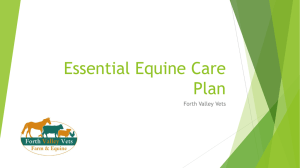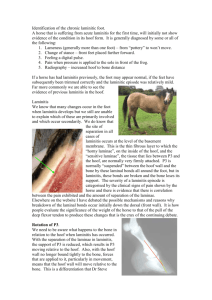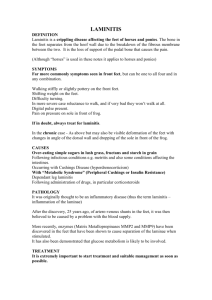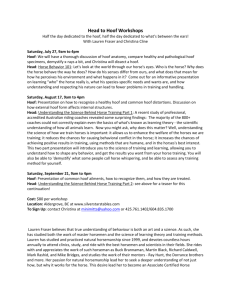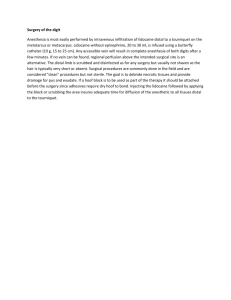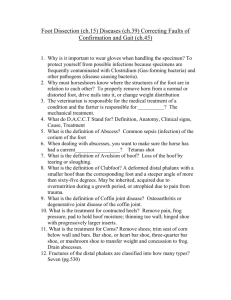Hoof Complications
advertisement
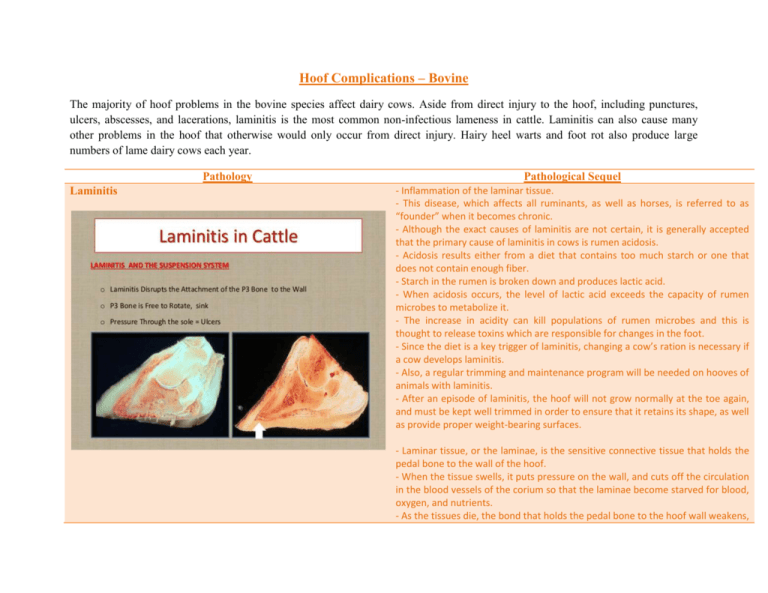
Hoof Complications – Bovine The majority of hoof problems in the bovine species affect dairy cows. Aside from direct injury to the hoof, including punctures, ulcers, abscesses, and lacerations, laminitis is the most common non-infectious lameness in cattle. Laminitis can also cause many other problems in the hoof that otherwise would only occur from direct injury. Hairy heel warts and foot rot also produce large numbers of lame dairy cows each year. Pathology Laminitis Pathological Sequel - Inflammation of the laminar tissue. - This disease, which affects all ruminants, as well as horses, is referred to as “founder” when it becomes chronic. - Although the exact causes of laminitis are not certain, it is generally accepted that the primary cause of laminitis in cows is rumen acidosis. - Acidosis results either from a diet that contains too much starch or one that does not contain enough fiber. - Starch in the rumen is broken down and produces lactic acid. - When acidosis occurs, the level of lactic acid exceeds the capacity of rumen microbes to metabolize it. - The increase in acidity can kill populations of rumen microbes and this is thought to release toxins which are responsible for changes in the foot. - Since the diet is a key trigger of laminitis, changing a cow’s ration is necessary if a cow develops laminitis. - Also, a regular trimming and maintenance program will be needed on hooves of animals with laminitis. - After an episode of laminitis, the hoof will not grow normally at the toe again, and must be kept well trimmed in order to ensure that it retains its shape, as well as provide proper weight-bearing surfaces. - Laminar tissue, or the laminae, is the sensitive connective tissue that holds the pedal bone to the wall of the hoof. - When the tissue swells, it puts pressure on the wall, and cuts off the circulation in the blood vessels of the corium so that the laminae become starved for blood, oxygen, and nutrients. - As the tissues die, the bond that holds the pedal bone to the hoof wall weakens, and the bone begins to separate from the wall. - With less support, and a weaker bond to the wall, the pedal bone begins to pull from the deep flexor tendon and rotates in the hoof. - Hooves that are afflicted with laminitis also begin to grow at abnormal rates due to increased vascularization, altering the shape of the hoof and adding more discomfort to the animal. - The chronic condition of laminitis is then called “founder”. White line disease (an adverse effect, secondary to laminitis) In cattle, laminitis itself is not nearly as detrimental as the side effects that it produces. Although laminitis will produce lame cattle, the other hoof problems that develop as side effects of laminitis are usually more severe. Laminitis in cattle results from dysfunction of the blood vessels serving the laminae and from softening of the ligaments of the suspensory apparatus leading to rotation of the pedal bone and compression of the digital cushion. This causes hemorrhages in the sole, as well as formation of lower quality horn in the hoof. When the bone begins to separate from the wall, it can cause the sole to separate from the wall at the white line, a disease known as white line disease. If the white line pulls too far away from the sole it can open the hoof up to infections. Solar abscesses (secondary to Laminitis) Under run heels (secondary to Laminitis) Excessive overgrowth of the toe Papilomatous Interdigital Dermatitis (Hairy heel warts) -Hairy heel warts or interdigital dermatitis is an infection that occurs mostly in dairy cows, producing inflamed, red lesions on the interdigital skin of the hoof. -Hairy heel warts are thought to be caused by strains of the anaerobic bacteria Treponema. These bacteria thrive in muddy, dirty, and damp conditions. TREATMENT -When foot warts are observed, the best way to treat them is with a footbath or a topical spray containing several remedies. -Antibiotics such as oxytetracycline or lincomycin are preferred by many veterinarians, although some people still choose to use formalin as a treatment for foot warts. -Formalin use is highly discouraged due to the carcinogenic properties of the chemical. -Cleaning the aisles and stalls of the cow barn will also help to alleviate the problems that the manure and mud can cause to the hoof, and prevent further infections of heel warts. Hoof Rot -Hoof rot in cattle is caused by the bacteria Fusobacterium necophorum. These are anaerobic bacteria that thrive in muddy, damp conditions. -Hoof rot can be characterized by a variety of symptoms. The animal will most likely exhibit some degree of lameness. Other symptoms may include a foul smelling discharge, reddened tissue above the hoof, and possibly swelling of the hoof and spreading of the toes. TREATMENT -Treatment for hoof rot in dairy cattle consists of treatment with systemic antibiotics that will not interfere with milking and do not have a milk withdrawal time. -The key to treating and preventing hoof rot in cattle is by keeping the living quarters as clean as possible, by regular hoof trimming, and through the use of footbaths. -Typically, copper sulfate is used in footbaths to harden the hoof and adjacent tissue, making it more difficult for bacterial infection to become established. Oral feeding of increase levels of biotin and zinc may harden the hoof tissue as well.
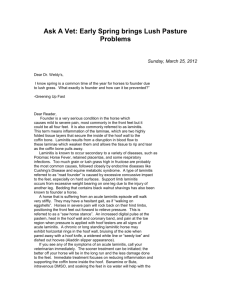
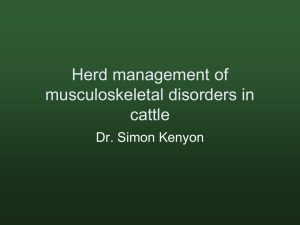
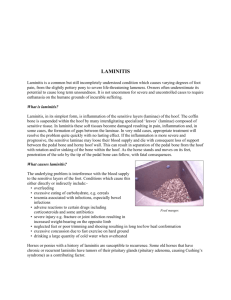
![founder [foun-der] * verb](http://s3.studylib.net/store/data/006663793_1-d5e428b162d474d6f8f7823b748330b0-300x300.png)
